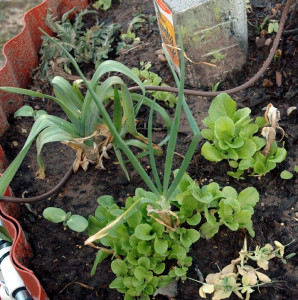 The spring season of 2014 is now under way at Keyhole Farm. It’s still not too late to obtain one of our kits and plant your garden, since keyhole gardens can be used all year long, fall, winter, spring, and summer.
The spring season of 2014 is now under way at Keyhole Farm. It’s still not too late to obtain one of our kits and plant your garden, since keyhole gardens can be used all year long, fall, winter, spring, and summer.
This year we experimented in the winter with 2-litre bottles covering some of the plants, as sort of a mini-greenhouse. This idea was submitted by a friend in Minnesota. The results were that the crops started under the bottles came up quicker and grew bigger in their early stages than those left outside. I used these, too, during frost days to great advantage. Some of the bottles were round like soft drinks come in and others were square-shaped, which orange juice comes in. You just cut off the bottom of the bottle and place the cut-out area directly over the plant or seed that has been put in the ground. Even on a cold day, if you put a finger into the top of the bottle, it is noticeably warmer inside, which bodes very well in freezing weather.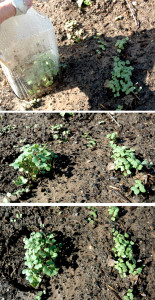
Here is an image of one of our experiments (click on images to enlarge). Note how the plants at the left are larger than the uncovered ones at the right. In most cases, seeds sprouted sooner in the covered areas.
Texas Gardener magazine included Keyhole Farm in its March/April edition, which I am pretty sure brought exposure enough to prompt more than the usual number of orders for our kits this spring because we have been swamped. We generally try to have a few kits in stock, but we have been literally working night and day just to keep up with orders when they come in. Here is a photo of one day’s shipping.
 We planted our spring gardens in full about two weeks ago and already have some plants coming up. We planted a couple of our mini-keyholes a little earlier so they are further developed, one already producing sweet peas.
We planted our spring gardens in full about two weeks ago and already have some plants coming up. We planted a couple of our mini-keyholes a little earlier so they are further developed, one already producing sweet peas.
The other images on this page depict where we are right now with some of our spring crops. I expect with warmer weather that in a few days we will have plants overflowing.
In one of the images is a bird feeder I built out of a gourd I grew last year, saving one for that purpose. How it does and whether it stays is yet unknown, but I like birds attracted to my gardens which I think is useful when grasshoppers drop by for a visit. I also raise mammoth sunflowers for this purpose and because yellow is my favorite color.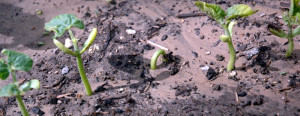
People usually ask how I water my gardens. Since I have 10 of them at our experiment location and am gone sometimes myself, I have two zones rigged up for nine of them whereby half water at a time, based on what I input on my contr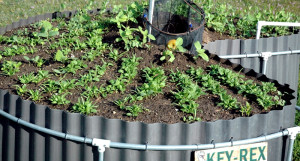 ol box inside. We originally used regular sprinkler heads in the middle of the gardens that had adjustments to eliminate watering the wedge area. Last year, we converted about half of them to macro-tubing with small heads going around the exterior of the gardens, about 11 heads in all, based on a 180-degree output.
ol box inside. We originally used regular sprinkler heads in the middle of the gardens that had adjustments to eliminate watering the wedge area. Last year, we converted about half of them to macro-tubing with small heads going around the exterior of the gardens, about 11 heads in all, based on a 180-degree output.
This year, I re-examined the set-up and asked myself, “Leon, why are you putting these macros around the exterior, why not simply go around the internal basket, which is less tubing and greater pressure output, plus would require fewer heads?” So we did that to all the gardens except one, so far with super results, utilizing just five mini-heads per garden.
We are currently getting ready for Dr. Deb Tolman’s spring keyhole garden tour set for the end of the month. If anyone wants to see our gardens in person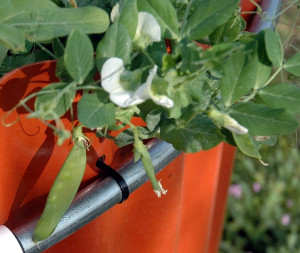 at other times, please feel free to drop by. I do ask that you let me know in advance of your approximate arrival time so that I will be sure to be around. Sometimes I am away running errands, etc. and would like to visit with guests. My cell phone number is (254) 652-9483 or I can be e-mailed at smith@keyholefarm.com.
at other times, please feel free to drop by. I do ask that you let me know in advance of your approximate arrival time so that I will be sure to be around. Sometimes I am away running errands, etc. and would like to visit with guests. My cell phone number is (254) 652-9483 or I can be e-mailed at smith@keyholefarm.com.
If you run a nursery or something similar and want to offer our garden kits to customers locally, please let me know. Also, please note that several schools and nursing homes have bought our kits. A non-profit in Oklahoma, for instance, recently purchased five kits, three regular sized ones for schools and two mini-keyholes for nursing homes since these are ADA compliant and easy for the wheelchair-bound to enjoy. Several Texas schools have purchased our kits. I am sure that I-pads and I-phones and such are nice, but nothing beats growing crops. It is a learning experience that stays with you always and it’s fun to do. Keyholes are the 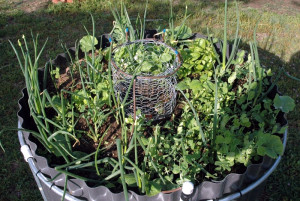 best place to start.
best place to start.
I don’t think I have mentioned this before, but all of our kits are hand-tooled, made in the United States here in Central Texas. It takes us longer to build each kit than it takes for the typical customer to put it together.